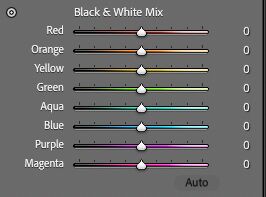Black and white photography -- do you use one of the primary colors to convert or just all colors?
Feb 11, 2024 10:56:27 #
I know some people use a lens filter to only let in green light when they want to ultimately convert the image to black and white. That way they get to minimize chromatic aberration and other distortions present when light of widely different wave lengths hits the glass.
But if you take color pictures and later decide to convert them to black and white, do you pick one of the colors or just overall luminance? Or some other system or method?
But if you take color pictures and later decide to convert them to black and white, do you pick one of the colors or just overall luminance? Or some other system or method?
Feb 11, 2024 11:09:47 #
Ysarex
Loc: St. Louis
JZA B1 wrote:
I know some people use a lens filter to only let in green light when they want to ultimately convert the image to black and white. That way they get to minimize chromatic aberration and other distortions present when light of widely different wave lengths hits the glass.
But if you take color pictures and later decide to convert them to black and white, do you pick one of the colors or just overall luminance? Or some other system or method?
But if you take color pictures and later decide to convert them to black and white, do you pick one of the colors or just overall luminance? Or some other system or method?
Here's a recent example of one of my B&W images from this past week: https://www.uglyhedgehog.com/t-799303-1.html#14445233
I save only raw files which are of course color images (no camera filters). I convert to B&W in my raw conversion software -- usually C1 which allows me to target and lighten/darken any one of the six primary/secondary colors. I then apply a desired tint to the monochrome image.
Feb 11, 2024 11:10:17 #
It depends on the editor connotation for color.
With one editor I just take the saturation down to zero --> Black and white.
Then I adjust the contrast and brightness as desired.
I always shoot color, that way I have it available if I desire.
It's much easier to make a B&W from a color shot than color from a B&W shot.
With one editor I just take the saturation down to zero --> Black and white.
Then I adjust the contrast and brightness as desired.
I always shoot color, that way I have it available if I desire.
It's much easier to make a B&W from a color shot than color from a B&W shot.
Feb 11, 2024 11:13:51 #
JZA B1 wrote:
I know some people use a lens filter to only let in green light when they want to ultimately convert the image to black and white. That way they get to minimize chromatic aberration and other distortions present when light of widely different wave lengths hits the glass.
But if you take color pictures and later decide to convert them to black and white, do you pick one of the colors or just overall luminance? Or some other system or method?
But if you take color pictures and later decide to convert them to black and white, do you pick one of the colors or just overall luminance? Or some other system or method?
Most editors have simple button/click and wala B&W. I always shoot raw, although jpg also works and I have the option of color and/or B&W. In fact every time I import a file into LrC I click on the B&W setting to see if it has potential for B&W as color is the default. There are additional tools that take any photo and process B&W - NIK silver for instance, which can be invoked from within LR/PS. With LrC being non-destructive I can have one input file and any number of processed output files. If I'm working in B&W I can have one High Key, another low key and many others. Same with the color version.
Feb 11, 2024 11:27:23 #
JZA B1 wrote:
I know some people use a lens filter to only let in green light when they want to ultimately convert the image to black and white. That way they get to minimize chromatic aberration and other distortions present when light of widely different wave lengths hits the glass.
But if you take color pictures and later decide to convert them to black and white, do you pick one of the colors or just overall luminance? Or some other system or method?
But if you take color pictures and later decide to convert them to black and white, do you pick one of the colors or just overall luminance? Or some other system or method?
Black and white is very subjective in my opinion, and I personally like to make my own and not rely on plugins to give me someone else's version of black and white. There are many different techniques of course, but I usually start with a black-and-white adjustment layer in Photoshop, which utilizes six colors (RGBCMY) to adjust the tones, and once I have the basic image I will often apply a gradient map adjustment layer to tweak the tones. In the gradient map, you can add as many points as desired to get very specific about which tones are affected. I don't think that simply desaturating an image is sufficient to make a good black-and-white photo.
Feb 11, 2024 11:54:21 #
JZA B1 wrote:
I know some people use a lens filter to only let in green light when they want to ultimately convert the image to black and white. That way they get to minimize chromatic aberration and other distortions present when light of widely different wave lengths hits the glass.
But if you take color pictures and later decide to convert them to black and white, do you pick one of the colors or just overall luminance? Or some other system or method?
But if you take color pictures and later decide to convert them to black and white, do you pick one of the colors or just overall luminance? Or some other system or method?
If you convert in Lightroom Classic you have the option of several hue sliders that can make major alterations to the photograph. This is far more flexible than capturing with a filer over the lens and lets you play "what if" as much as you like. If you do the conversion in Photoshop you are only slightly more limited as the number of colors in the B&W Adjustment Layer are fewer.
Some people will also radically alter the appearance of the image in LrC sliders in the Basic Panel in LrC especially the texture, clarity, and dehaze sliders before the B&W conversion.
LrC sliders available after selecting B&W

Feb 11, 2024 11:56:35 #
I use the dual hue/saturation adjustment layer method to convert B&W tp color in Photoshop. It is the third method in this tutorial which has several methods. It results in adjusting just one slider to show the whole range of possible results.
https://www.dpchallenge.com/tutorial.php?TUTORIAL_ID=43
https://www.dpchallenge.com/tutorial.php?TUTORIAL_ID=43
Feb 11, 2024 12:02:04 #
delder
Loc: Maryland
JZA B1 wrote:
I know some people use a lens filter to only let in green light when they want to ultimately convert the image to black and white. That way they get to minimize chromatic aberration and other distortions present when light of widely different wave lengths hits the glass.
But if you take color pictures and later decide to convert them to black and white, do you pick one of the colors or just overall luminance? Or some other system or method?
But if you take color pictures and later decide to convert them to black and white, do you pick one of the colors or just overall luminance? Or some other system or method?
I use my available tools depending on the original color photo and the results that appeal to me.
Remember, there is always a picture within a picture!
Feb 11, 2024 12:02:58 #
delder
Loc: Maryland
Longshadow wrote:
It depends on the editor connotation for color.
With one editor I just take the saturation down to zero --> Black and white.
Then I adjust the contrast and brightness as desired.
I always shoot color, that way I have it available if I desire.
It's much easier to make a B&W from a color shot than color from a B&W shot.
With one editor I just take the saturation down to zero --> Black and white.
Then I adjust the contrast and brightness as desired.
I always shoot color, that way I have it available if I desire.
It's much easier to make a B&W from a color shot than color from a B&W shot.
Sounds like my approach!
Feb 11, 2024 12:11:56 #
BobHartung wrote:
If you convert in Lightroom Classic you have the o... (show quote)
You are never "more limited" in Photoshop than in Lightroom, since if you deem it necessary to use Orange and Purple, you always have Camera Raw and all the Lightroom tools available from the filter menu in Photoshop, and you can always use them non-destructively.
Feb 11, 2024 12:16:21 #
terryMc wrote:
You are never "more limited" in Photoshop than in Lightroom, since if you deem it necessary to use Orange and Purple, you always have Camera Raw and all the Lightroom tools available from the filter menu in Photoshop, and you can always use them non-destructively.
You see it your way, I'll see it my way.
Feb 11, 2024 12:19:33 #
BobHartung wrote:
You see it your way, I'll see it my way.
I see the reality—I don't know what you see.
Feb 11, 2024 12:38:13 #
terryMc wrote:
I see the reality—I don't know what you see.
Stooping to a new low! Just accept the fact that we use the tools differently.
Feb 11, 2024 13:29:53 #
Adjusting the weighting of the various colors to obtain a a “look” of a BW photo is a useful technique. A while ago a new conversion feature was added to LrC (and possibly ACR in Ps, I don’t know) that allows you to quickly see your image with a number of profiles. And there is a BIG difference! Rumor has it that the guy that created those profiles made the ones used in SilverFix. I use them even though I don’t have a clue how to create ones I like.
Feb 11, 2024 13:48:25 #
Looks like a lot of partial answers here, but as far as what colors to use not much help. I'm going to be either but I suggest you get on YouTube and pose the question -- I remember seeing a video on there that showed what each color did with respect to changing to B&W. As I recall, red was very prominent. You could try an experiment with photo that has lots of color and then adjust each of the primary colors and see what happens and eventually combinations.
Jack
Jack
If you want to reply, then register here. Registration is free and your account is created instantly, so you can post right away.





